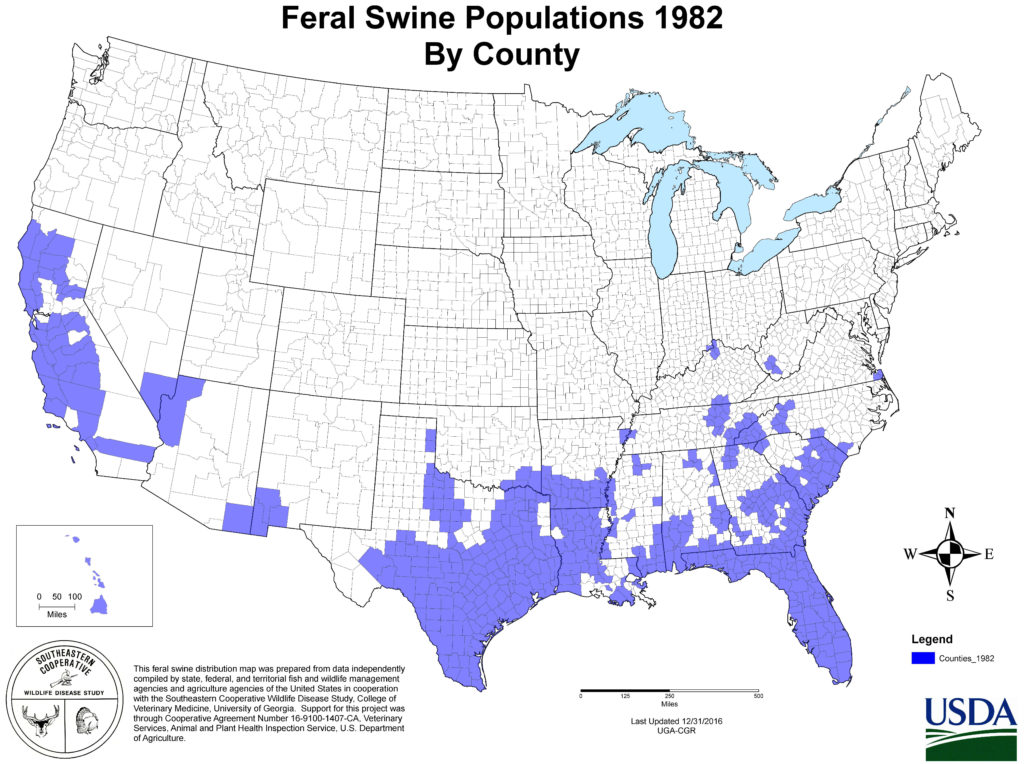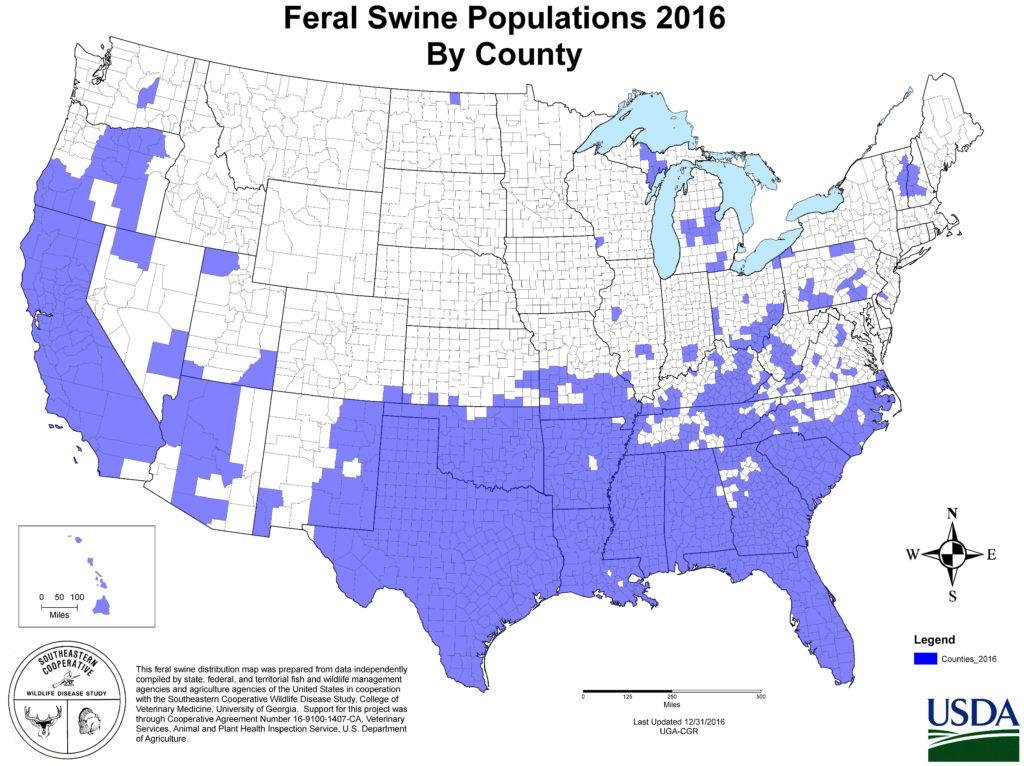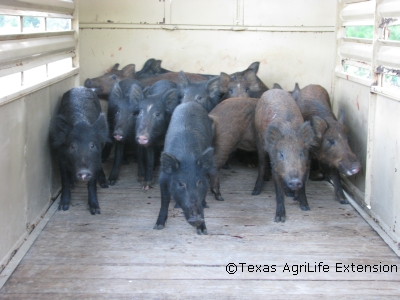Where are feral hogs found today?
Feral hogs have expanded dramatically from their native range within the Eurasian super-continent to the point that they are currently found on every continent except for Antarctica. As of 2019, feral hogs have been reporteded in 35 out of 50 states in the United States of America. In Texas, data from 2022 has indicated that feral hogs are established in 253 of 254 counties in Texas.

How did their range expand so dramatically?
The range of feral hogs in the United States has expanded steadily over time until recent years when the extent of their range began to increase dramatically. In 1982 only 18 states reported established feral hog populations, but by 2016, the number of occupied states had jumped to 35. While there is no singular cause for the expansion of feral hogs, some of the contributing factors include human assisted movements, natural movements, and changes in land use.
Human-assisted movement
In their native range, hunting wild boar has been a well-established activity for centuries. In the United States, interest in hunting Eurasian wild boar led to intentional releases of these animals across the country. As natural expansions, accidental releases, and intentional releases of feral hogs occurred, their range began to grow more rapidly. Many occupied states attempted to regulate the population growth and limit the expansion of the species by mobilizing hunters with combinations of open seasons and no bag limits for the hogs. Unfortunately, in many places hunting of feral hogs actually increased human assisted movement of feral hogs. Interest in hunting feral hogs has created a demand for them. By looking at range maps and genetic analysis, we can identify areas where people have intentionally released feral hogs to create additional opportunities for hunters and additional revenue opportunities for guides and landowners.
Today the movement and intentional release of feral hogs is regulated in most places that they occur. In Texas, movement of feral hogs has been regulated since 2008. Feral hogs in Texas can only be transported alive for the following reasons:
- Male and female hogs can be transported to an approved approved holding facility who will then transport the feral hogs to a slaughter facility or an approved hunting preserve.
- Male and female hogs can be transported directly to an approved slaughter facility.
- Male hogs can also be sold to an authorized hunting preserve. Preserves must be approved and permitted by the Texas Animal Health Commission, and regularly inspected to ensure that escape is not possible.
Natural movement
While many factors have influenced the rapid expansion of feral hog populations, natural movement and expansion to adjacent areas still plays a role in the success of this invasive species. The high adaptability and high reproductive rates associated with feral hogs allows them to expand into adjacent areas when conditions become favorable due to population pressures, land use changes, or new resource availability. This process can account for much of the initial expansion of the species, as well as subsequent expansion after human assisted movements.
Changes in land use
Land use is changes have also contributed to the expansion of the range of feral hogs. Landscape changes can take on a variety of forms and some changes actually make areas more hospitable to feral hogs that may not have been previously. Areas that are managed intensely for wildlife or livestock often involve providing supplemental feed and supplemental water. These efforts to grow wildlife populations can also contribute to feral hog expansion if not done with proper exclusion practices. Additionally, supplemental water can provide important thermo regulation opportunities for feral hogs, thus contributing to their range expansion.
Another land use to consider that has a variety of impacts on feral hogs is large scale crop production. When cropland is located adjacent to suitable habitat, agricultural practices can provide local hogs with food, water, or shelter depending on the crop type. However, large scale crop production can expand to an extent where it actually acts as a barrier to feral hogs (and other wildlife species). When portions of an agricultural operation are left to fallow or rest, the area can become accessible to feral hogs again due to the lack of pressure from crop damage protection efforts. The relationship between feral hogs and croplands is complex. Efforts should be made to protect crops from feral hog damage whenever possible to discourage establishment in the area.
A more social shift in land use is the practice of absentee land ownership. Feral hog populations are best managed right at the time of establishment. If the owners of a property do not live onsite, they may not notice signs of feral hog presence until a population is well established in the area. Additionally, many feral hog management practices require someone to be onsite or nearby to scout locations, bait areas, maintain traps, and remove or dispatch captured hogs. These practices may be more difficult for landowners who are not on site to implement.
Urbanization
Worldwide, urbanization is one of the fastest growing types of land use change, and predictions expect this trend to continue in coming years. Urban environments can provide the resources necessary for a habitat generalist such as a feral hog to flourish. Gardens, domestic trash, direct feeding, and pet food are all novel food sources available in urban environments, and parks and greenbelts can also provide natural food sources. Urban environments also include a variety of water features that can provide important cooling opportunities for feral hogs. While urban environments are not the primary cause for feral hog expansion, it is another type of landscape that can be exploited by feral hogs and one that often leads to increased contact with humans.
Eradication: The Goal of Feral Hog Management
Feral hogs are a highly adaptable species that have a high rate of success for invading new areas. There are a variety of tools available for management, but at minimum, further range expansion should be prevented. The ultimate goal of feral hog management is eradication. While eradication can seem like a lofty goal when looking at a range map, a good starting point is halting their expansion then focusing on reducing their distribution whenever possible. It is important to be diligent in monitoring for feral hogs because if their presence can be identified early, they are much easier to locally eradicate from an area.



